Lianmin Zheng
BlendServe: Optimizing Offline Inference for Auto-regressive Large Models with Resource-aware Batching
Nov 25, 2024



Abstract:Offline batch inference, which leverages the flexibility of request batching to achieve higher throughput and lower costs, is becoming more popular for latency-insensitive applications. Meanwhile, recent progress in model capability and modality makes requests more diverse in compute and memory demands, creating unique opportunities for throughput improvement by resource overlapping. However, a request schedule that maximizes resource overlapping can conflict with the schedule that maximizes prefix sharing, a widely-used performance optimization, causing sub-optimal inference throughput. We present BlendServe, a system that maximizes resource utilization of offline batch inference by combining the benefits of resource overlapping and prefix sharing using a resource-aware prefix tree. BlendServe exploits the relaxed latency requirements in offline batch inference to reorder and overlap requests with varied resource demands while ensuring high prefix sharing. We evaluate BlendServe on a variety of synthetic multi-modal workloads and show that it provides up to $1.44\times$ throughput boost compared to widely-used industry standards, vLLM and SGLang.
Post-Training Sparse Attention with Double Sparsity
Aug 11, 2024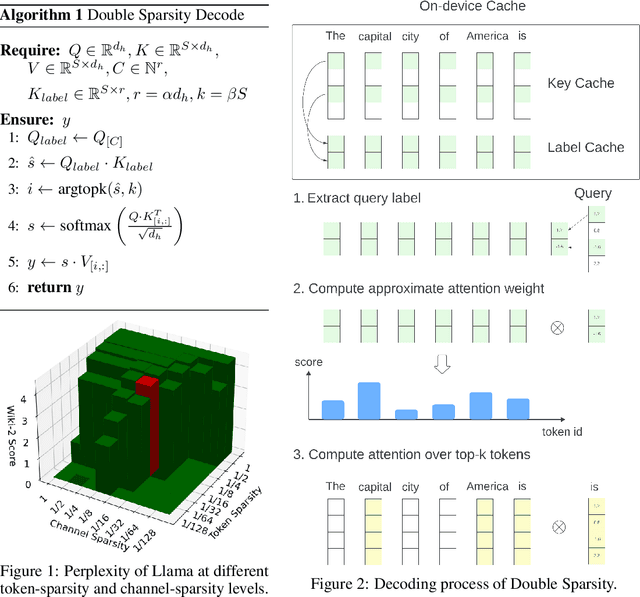


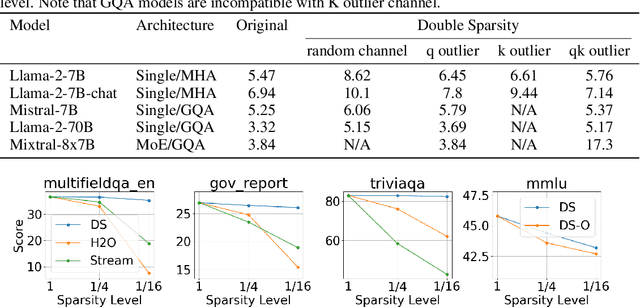
Abstract:The inference process for large language models is slow and memory-intensive, with one of the most critical bottlenecks being excessive Key-Value (KV) cache accesses. This paper introduces "Double Sparsity," a novel post-training sparse attention technique designed to alleviate this bottleneck by reducing KV cache access. Double Sparsity combines token sparsity, which focuses on utilizing only the important tokens for computing self-attention, with channel sparsity, an approach that uses important feature channels for identifying important tokens. Our key insight is that the pattern of channel sparsity is relatively static, allowing us to use offline calibration to make it efficient at runtime, thereby enabling accurate and efficient identification of important tokens. Moreover, this method can be combined with offloading to achieve significant memory usage reduction. Experimental results demonstrate that Double Sparsity can achieve \(\frac{1}{16}\) token and channel sparsity with minimal impact on accuracy across various tasks, including wiki-2 perplexity, key-value retrieval, and long context benchmarks with models including Llama-2-7B, Llama-2-70B, and Mixtral-8x7B. It brings up to a 14.1$\times$ acceleration in attention operations and a 1.9$\times$ improvement in end-to-end inference on GPUs. With offloading, it achieves a decoding speed acceleration of 16.3$\times$ compared to state-of-the-art solutions at a sequence length of 256K. Our code is publicly available at \url{https://github.com/andy-yang-1/DoubleSparse}.
Chatbot Arena: An Open Platform for Evaluating LLMs by Human Preference
Mar 07, 2024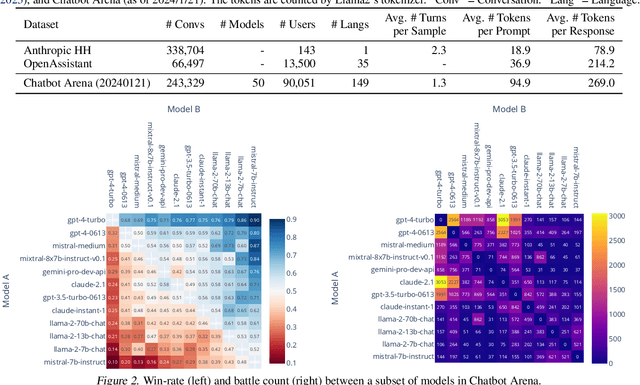
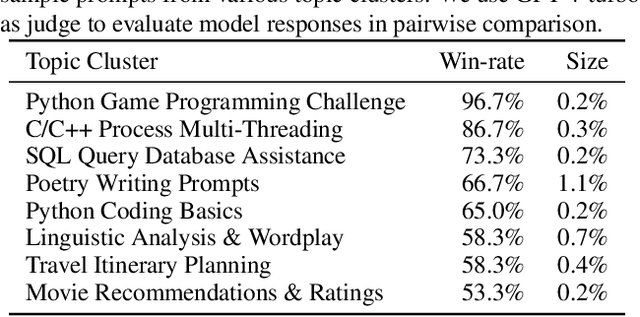
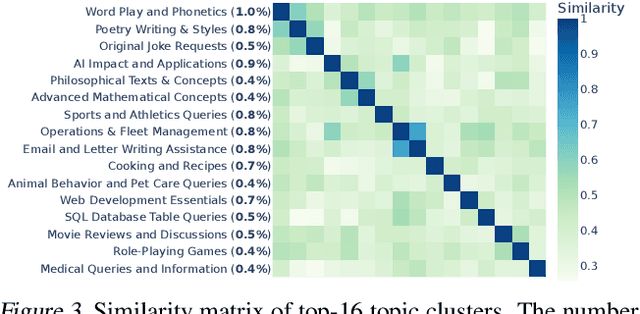
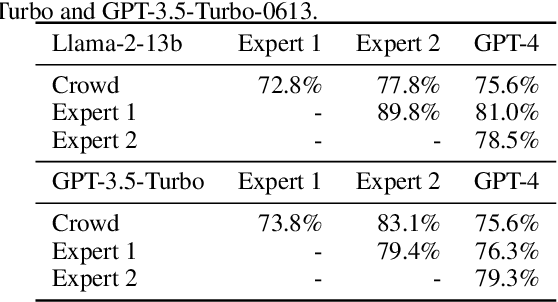
Abstract:Large Language Models (LLMs) have unlocked new capabilities and applications; however, evaluating the alignment with human preferences still poses significant challenges. To address this issue, we introduce Chatbot Arena, an open platform for evaluating LLMs based on human preferences. Our methodology employs a pairwise comparison approach and leverages input from a diverse user base through crowdsourcing. The platform has been operational for several months, amassing over 240K votes. This paper describes the platform, analyzes the data we have collected so far, and explains the tried-and-true statistical methods we are using for efficient and accurate evaluation and ranking of models. We confirm that the crowdsourced questions are sufficiently diverse and discriminating and that the crowdsourced human votes are in good agreement with those of expert raters. These analyses collectively establish a robust foundation for the credibility of Chatbot Arena. Because of its unique value and openness, Chatbot Arena has emerged as one of the most referenced LLM leaderboards, widely cited by leading LLM developers and companies. Our demo is publicly available at \url{https://chat.lmsys.org}.
Efficiently Programming Large Language Models using SGLang
Dec 12, 2023Abstract:Large language models (LLMs) are increasingly used for complex tasks requiring multiple chained generation calls, advanced prompting techniques, control flow, and interaction with external environments. However, efficient systems for programming and executing these applications are lacking. To bridge this gap, we introduce SGLang, a Structured Generation Language for LLMs. SGLang is designed for the efficient programming of LLMs and incorporates primitives for common LLM programming patterns. We have implemented SGLang as a domain-specific language embedded in Python, and we developed an interpreter, a compiler, and a high-performance runtime for SGLang. These components work together to enable optimizations such as parallelism, batching, caching, sharing, and other compilation techniques. Additionally, we propose RadixAttention, a novel technique that maintains a Least Recently Used (LRU) cache of the Key-Value (KV) cache for all requests in a radix tree, enabling automatic KV cache reuse across multiple generation calls at runtime. SGLang simplifies the writing of LLM programs and boosts execution efficiency. Our experiments demonstrate that SGLang can speed up common LLM tasks by up to 5x, while reducing code complexity and enhancing control.
Rethinking Benchmark and Contamination for Language Models with Rephrased Samples
Nov 11, 2023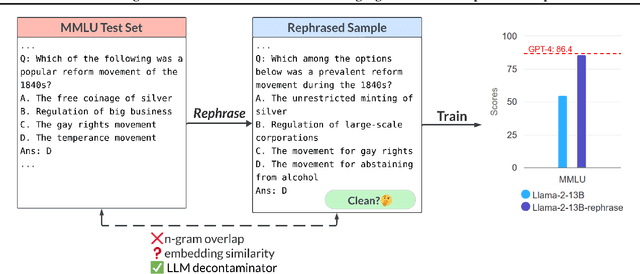

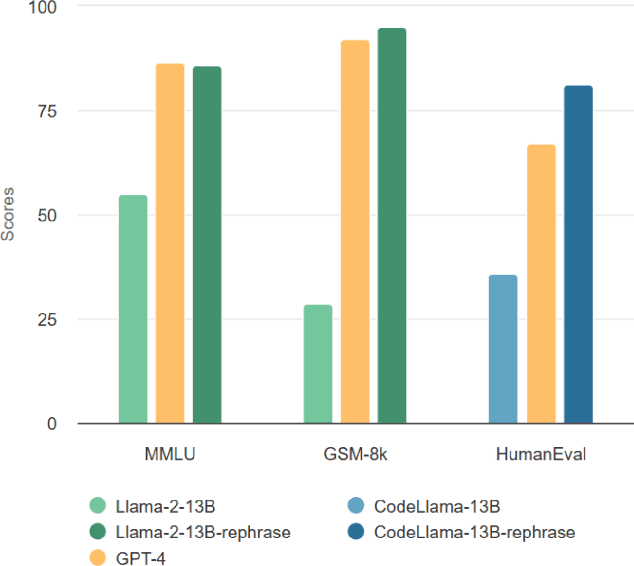
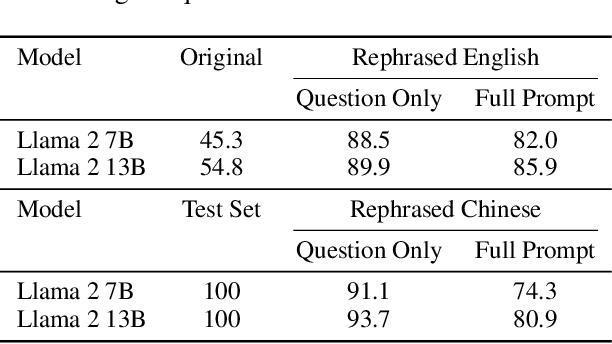
Abstract:Large language models are increasingly trained on all the data ever produced by humans. Many have raised concerns about the trustworthiness of public benchmarks due to potential contamination in pre-training or fine-tuning datasets. While most data decontamination efforts apply string matching (e.g., n-gram overlap) to remove benchmark data, we show that these methods are insufficient, and simple variations of test data (e.g., paraphrasing, translation) can easily bypass these decontamination measures. Furthermore, we demonstrate that if such variation of test data is not eliminated, a 13B model can easily overfit a test benchmark and achieve drastically high performance, on par with GPT-4. We validate such observations in widely used benchmarks such as MMLU, GSK8k, and HumanEval. To address this growing risk, we propose a stronger LLM-based decontamination method and apply it to widely used pre-training and fine-tuning datasets, revealing significant previously unknown test overlap. For example, in pre-training sets such as RedPajama-Data-1T and StarCoder-Data, we identified that 8-18\% of the HumanEval benchmark overlaps. Interestingly, we also find such contamination in synthetic dataset generated by GPT-3.5/4, suggesting a potential risk of unintentional contamination. We urge the community to adopt stronger decontamination approaches when using public benchmarks. Moreover, we call for the community to actively develop fresh one-time exams to evaluate models accurately. Our decontamination tool is publicly available at https://github.com/lm-sys/llm-decontaminator.
S-LoRA: Serving Thousands of Concurrent LoRA Adapters
Nov 07, 2023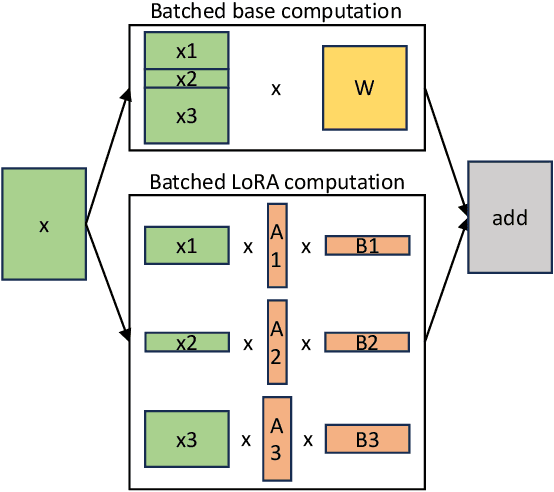
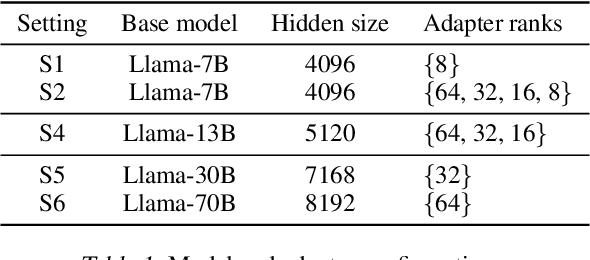
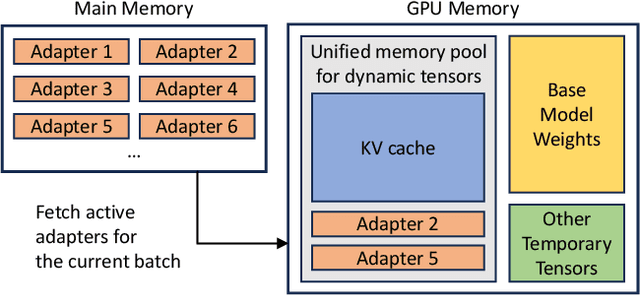
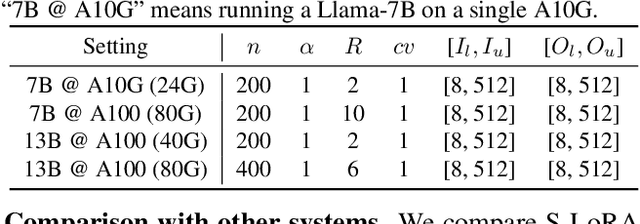
Abstract:The "pretrain-then-finetune" paradigm is commonly adopted in the deployment of large language models. Low-Rank Adaptation (LoRA), a parameter-efficient fine-tuning method, is often employed to adapt a base model to a multitude of tasks, resulting in a substantial collection of LoRA adapters derived from one base model. We observe that this paradigm presents significant opportunities for batched inference during serving. To capitalize on these opportunities, we present S-LoRA, a system designed for the scalable serving of many LoRA adapters. S-LoRA stores all adapters in the main memory and fetches the adapters used by the currently running queries to the GPU memory. To efficiently use the GPU memory and reduce fragmentation, S-LoRA proposes Unified Paging. Unified Paging uses a unified memory pool to manage dynamic adapter weights with different ranks and KV cache tensors with varying sequence lengths. Additionally, S-LoRA employs a novel tensor parallelism strategy and highly optimized custom CUDA kernels for heterogeneous batching of LoRA computation. Collectively, these features enable S-LoRA to serve thousands of LoRA adapters on a single GPU or across multiple GPUs with a small overhead. Compared to state-of-the-art libraries such as HuggingFace PEFT and vLLM (with naive support of LoRA serving), S-LoRA can improve the throughput by up to 4 times and increase the number of served adapters by several orders of magnitude. As a result, S-LoRA enables scalable serving of many task-specific fine-tuned models and offers the potential for large-scale customized fine-tuning services. The code is available at https://github.com/S-LoRA/S-LoRA
LMSYS-Chat-1M: A Large-Scale Real-World LLM Conversation Dataset
Sep 30, 2023



Abstract:Studying how people interact with large language models (LLMs) in real-world scenarios is increasingly important due to their widespread use in various applications. In this paper, we introduce LMSYS-Chat-1M, a large-scale dataset containing one million real-world conversations with 25 state-of-the-art LLMs. This dataset is collected from 210K unique IP addresses in the wild on our Vicuna demo and Chatbot Arena website. We offer an overview of the dataset's content, including its curation process, basic statistics, and topic distribution, highlighting its diversity, originality, and scale. We demonstrate its versatility through four use cases: developing content moderation models that perform similarly to GPT-4, building a safety benchmark, training instruction-following models that perform similarly to Vicuna, and creating challenging benchmark questions. We believe that this dataset will serve as a valuable resource for understanding and advancing LLM capabilities. The dataset is publicly available at https://huggingface.co/datasets/lmsys/lmsys-chat-1m.
Efficient Memory Management for Large Language Model Serving with PagedAttention
Sep 12, 2023Abstract:High throughput serving of large language models (LLMs) requires batching sufficiently many requests at a time. However, existing systems struggle because the key-value cache (KV cache) memory for each request is huge and grows and shrinks dynamically. When managed inefficiently, this memory can be significantly wasted by fragmentation and redundant duplication, limiting the batch size. To address this problem, we propose PagedAttention, an attention algorithm inspired by the classical virtual memory and paging techniques in operating systems. On top of it, we build vLLM, an LLM serving system that achieves (1) near-zero waste in KV cache memory and (2) flexible sharing of KV cache within and across requests to further reduce memory usage. Our evaluations show that vLLM improves the throughput of popular LLMs by 2-4$\times$ with the same level of latency compared to the state-of-the-art systems, such as FasterTransformer and Orca. The improvement is more pronounced with longer sequences, larger models, and more complex decoding algorithms. vLLM's source code is publicly available at https://github.com/vllm-project/vllm
H$_2$O: Heavy-Hitter Oracle for Efficient Generative Inference of Large Language Models
Jul 19, 2023Abstract:Large Language Models (LLMs), despite their recent impressive accomplishments, are notably cost-prohibitive to deploy, particularly for applications involving long-content generation, such as dialogue systems and story writing. Often, a large amount of transient state information, referred to as the KV cache, is stored in GPU memory in addition to model parameters, scaling linearly with the sequence length and batch size. In this paper, we introduce a novel approach for implementing the KV cache which significantly reduces its memory footprint. Our approach is based on the noteworthy observation that a small portion of tokens contributes most of the value when computing attention scores. We call these tokens Heavy Hitters (H$_2$). Through a comprehensive investigation, we find that (i) the emergence of H$_2$ is natural and strongly correlates with the frequent co-occurrence of tokens in the text, and (ii) removing them results in significant performance degradation. Based on these insights, we propose Heavy Hitter Oracle (H$_2$O), a KV cache eviction policy that dynamically retains a balance of recent and H$_2$ tokens. We formulate the KV cache eviction as a dynamic submodular problem and prove (under mild assumptions) a theoretical guarantee for our novel eviction algorithm which could help guide future work. We validate the accuracy of our algorithm with OPT, LLaMA, and GPT-NeoX across a wide range of tasks. Our implementation of H$_2$O with 20% heavy hitters improves the throughput over three leading inference systems DeepSpeed Zero-Inference, Hugging Face Accelerate, and FlexGen by up to 29$\times$, 29$\times$, and 3$\times$ on OPT-6.7B and OPT-30B. With the same batch size, H2O can reduce the latency by up to 1.9$\times$. The code is available at https://github.com/FMInference/H2O.
Judging LLM-as-a-judge with MT-Bench and Chatbot Arena
Jun 09, 2023



Abstract:Evaluating large language model (LLM) based chat assistants is challenging due to their broad capabilities and the inadequacy of existing benchmarks in measuring human preferences. To address this, we explore using strong LLMs as judges to evaluate these models on more open-ended questions. We examine the usage and limitations of LLM-as-a-judge, such as position and verbosity biases and limited reasoning ability, and propose solutions to migrate some of them. We then verify the agreement between LLM judges and human preferences by introducing two benchmarks: MT-bench, a multi-turn question set; and Chatbot Arena, a crowdsourced battle platform. Our results reveal that strong LLM judges like GPT-4 can match both controlled and crowdsourced human preferences well, achieving over 80\% agreement, the same level of agreement between humans. Hence, LLM-as-a-judge is a scalable and explainable way to approximate human preferences, which are otherwise very expensive to obtain. Additionally, we show our benchmark and traditional benchmarks complement each other by evaluating several variants of LLaMA/Vicuna. We will publicly release 80 MT-bench questions, 3K expert votes, and 30K conversations with human preferences from Chatbot Arena.
 Add to Chrome
Add to Chrome Add to Firefox
Add to Firefox Add to Edge
Add to Edge